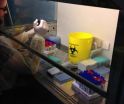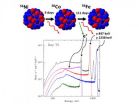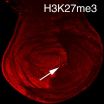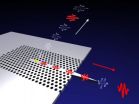(Press-News.org) The MERS coronavirus has caused disease outbreaks across the Arabian Peninsula and spread to Europe several times. The severe pneumonia virus has claimed the lives of several hundred people since its discovery in 2012. For a long time, scientists have been puzzled over how easily the pathogen spreads from human to human. An international team of researchers led by virologists from the University of Bonn have now come to the conclusion, through direct observation, that the rate of human transmission is low. Still, a third of infected persons with symptoms die. The results are now being presented in the renowned New England Journal of Medicine.
The "Middle East Respiratory Syndrome Coronavirus" (MERS-CoV) was detected for the first time in 2012 on the Arabian Peninsula from where it spread to Europe and the USA, among other places. The virus causes severe acute lung infection. A total of at least 856 cases of illness have been registered in the meantime and at least 241 people have died. Scientists are puzzling over how infectious the disease is and how high the estimated number of unrecognized cases is. To date, there have been only theoretical projections.
For the first time, an international team of scientists led by Professor Christian Drosten at the Institute of Virology has been able to directly determine the rate of infection. "The transmissibility of the virus and the estimated number of unknown cases are low," says Prof. Drosten, summarizing the results. In Saudi Arabia, after new infections occurred, the researchers tracked how the disease spread further in the patients' home environments. A total of 280 people who lived in the households of 26 infected persons were examined. There was an infection in not more than twelve cases (four percent). "Since each infected person infected significantly fewer than one additional person, it can be assumed that the MERS virus will not cause a pandemic," concludes the virologist. A disease spreads rapidly only if each infected person infects several other people.
Along with people, dromedaries are an additional source of infection
However, the scientists say there is no reason for complacency: "Even if the rate of transmission is low: The MERS infection is very dangerous and about one-third of symptomatic patients die from the infection," says Prof. Drosten. Along with person-to-person infection, there is another important source: As a team of researchers working with Prof. Drosten published a year ago, dromedaries may be involved in transmission of the virus. They are widespread in the Middle East and could be responsible for a portion of human illnesses due to their close contact with people.
In the virologist's opinion, the fact that MERS infection rates significantly increase in the spring supports this hypothesis. At this time, there are many newborn camels and the one-year-old animals are separated from mothers which respectively causes an increased risk of infection. "Preventing an infection passed from animal to animal and then to people is not easy," says Prof. Drosten. One option would be to develop a MERS vaccine for camels. However, in the vast region of the Arab Peninsula vaccination coverage is logistically difficult to implement.
Virologists from the University of Bonn Hospital develop a new test
The virologists from the University of Bonn Hospital have for the first time developed a reliable method for detecting MERS infections in Saudi Arabian households. This method is used for the serological detection of antibodies in the blood. The new test is to be marketed soon by a German company and it will then be available to all physicians. Access to the families of infected persons in the Arabic country was a significant challenge for the international team of researchers from Germany, Saudi Arabia, the Netherlands and England. Dr. Ziad Memish, who was then the deputy Minister of Health in Saudi Arabia and senior author of the publication, helped convince people to be examined for the study.
INFORMATION:
Publication: Transmission of MERS-Coronavirus in Household Contacts, The New England Journal of Medicine, DOI: 10.1056/NEJMoa1405858.
Media contact information:
Prof. Dr. Christian Drosten
Institute of Virology at the
University of Bonn Hospital
Tel. ++49-(0)228-28711055
E-Mail: drosten@virology-bonn.de
MERS: Low transmissibility, dangerous illness
Research led by the University of Bonn Virologists reveals transmission rate of the MERS virus
2014-08-29
ELSE PRESS RELEASES FROM THIS DATE:
Astrophysicists report radioactive cobalt in supernova explosion
2014-08-29
A group of astrophysicists, including researchers from MIPT, have detected the formation of radioactive cobalt during a supernova explosion, lending credence to a corresponding theory of supernova explosions. Details are given in the journal Nature, one of the most cited scientific publications in the world.
The article's main author, Yevgeny Churazov (Space Research Institute of the Russian Academy of Sciences), together with his co-authors, including Sergei Sazonov of the Space Research Institute and MIPT, reported the results of their analysis of data collected with ...
Cellphone addiction 'an increasingly realistic possibility,' Baylor study finds
2014-08-29
Women college students spend an average of 10 hours a day on their cellphones and men college students spend nearly eight, with excessive use posing potential risks for academic performance, according to a Baylor University study on cellphone activity published in the Journal of Behavioral Addictions.
"That's astounding," said researcher James Roberts, Ph.D., The Ben H. Williams Professor of Marketing in Baylor's Hankamer School of Business. "As cellphone functions increase, addictions to this seemingly indispensable piece of technology become an increasingly realistic ...
'K-to-M' histone mutations: How repressing the repressors may drive tissue-specific cancers
2014-08-29
Kansas City, MO. - In a cell's nucleus, chromosomal DNA is tightly bound to structural proteins known as histones, an amalgam biologists call chromatin. Until about two decades ago, histones were regarded as a nuclear "sidekick," the mere packing material around which the glamorous DNA strands were wrapped. Recently, however, biologists have developed a greater appreciation for how DNA/histone interactions govern gene expression.
In 2012, investigators from multiple research institutions studying the sequence of the genome from cancer patients rocked the "chromatin world" ...
Copper shines as flexible conductor
2014-08-29
Bend them, stretch them, twist them, fold them: modern materials that are light, flexible and highly conductive have extraordinary technological potential, whether as artificial skin or electronic paper.
Making such concepts affordable enough for general use remains a challenge but a new way of working with copper nanowires and a PVA "nano glue" could be a game-changer.
Previous success in the field of ultra-lightweight "aerogel monoliths" has largely relied on the use of precious gold and silver nanowires.
By turning instead to copper, both abundant and cheap, ...
Meaningful relationships can help you thrive
2014-08-29
In brief:
The definition of thriving involves 5 components of well-being
Relationships provide 2 types of support: source of strength (SOS) support, and relational catalyst (RC) support
Support-providers must be sensitive and responsive—there are characteristics in a support-provider that can lead to doing more harm than good
Future research should focus more on social support in non-adverse life circumstances
Deep and meaningful relationships play a vital role in overall well-being. Past research has shown that individuals with supportive and rewarding relationships ...
Plug n' play protein crystals
2014-08-29
Almost a hundred years ago in 1929 Linus Pauling presented the famous Pauling's Rules to describe the principles governing the structure of complex ionic crystals. These rules essentially describe how the arrangement of atoms in a crystal is critically dependent on the size of the atoms, their charge and type of bonding. According to scientists from the Biohybrid Materials Group of Aalto University Finland led by Mauri Kostiainen similar rules can be applied to prepare ionic colloidal crystals consisting of oppositely charged proteins and virus particles. The results can ...
Managing coasts under threat from climate change and sea-level rise
2014-08-29
Coastal regions under threat from climate change and sea-level rise need to tackle the more immediate threats of human-led and other non-climatic changes, according to a team of international scientists.
The team of 27 scientists from five continents, led by Dr Sally Brown at the University of Southampton, reviewed 24 years of Intergovernmental Panel on Climate Change (IPCC) assessments (the fifth and latest set being published in 2013 and 2014). They focused on climate change and sea-level rise impacts in the coastal zone, and examined ways of how to better manage and ...
Mobile app on emergency cardiac care aids best decisions in seconds
2014-08-29
Barcelona, Spain –Saturday 30 August 2014: The ACCA Clinical Decision-Making Toolkit mobile app is now available on the App Store and Google Play.
When dealing with acute cardiovascular diseases, a few seconds can make the difference and instant access to the best recommendations can save lives. This led the Acute Cardiovascular Care Association (ACCA) of the ESC to develop a user friendly interactive application, allowing professionals to have immediate access to diagnostics pathways on their mobile devices.
The Toolkit on emergency cardiac care, first published as ...
Breakthrough in light sources for new quantum technology
2014-08-29
Electronic circuits are based on electrons, but one of the most promising technologies for future quantum circuits are photonic circuits, i.e. circuits based on light (photons) instead of electrons. First, it is necessary to be able to create a stream of single photons and control their direction. Researchers around the world have made all sorts of attempts to achieve this control, but now scientists at the Niels Bohr Institute have succeeded in creating a steady stream of photons emitted one at a time and in a particular direction. The breakthrough has been published in ...
Real tremors, or drug-seeking patient? New app can tell
2014-08-29
A 42-year-old investment banker arrives at the emergency department with complaints of nausea, vomiting, anxiety and tremor. He drinks alcohol every day—often at business lunches, and at home every evening. Worried about his health, he decided to quit drinking and had his last Scotch 24 hours before coming to emergency.
It's a common scenario in emergency rooms across Canada—a patient suddenly stops regular, excessive alcohol consumption and develops withdrawal.
Withdrawal is a potentially fatal condition that is easily treated with benzodiazepine drugs, a class of ...
LAST 30 PRESS RELEASES:
The move by Apple Memories to block potentially upsetting content illustrates Big Tech’s reach and limits, writes Chrys Vilvang
Chemical tool illuminates pathways used by dopamine, opioids and other neuronal signals
Asian monsoon lofts ozone-depleting substances to stratosphere
PET scans reveal ‘smoldering’ inflammation in patients with multiple sclerosis
Genetics predict type 2 diabetes risk and disparities in childhood cancer survivors
Health information on TikTok: The good, the bad and the ugly
New study points to racial and social barriers that block treatment for multiple myeloma
Rensselaer researcher finds that frog species evolved rapidly in response to road salts
A new chapter in quantum vortices: Customizing electron vortex beams
Don’t be a stranger – study finds rekindling old friendships as scary as making new ones
There’s no ‘one size fits all’ when it comes to addressing men’s health issues globally
Comparison of the “late catch-up” phenomenon between BuMA Supreme and XIENCE stents through serial optical coherence tomography at 1–2 month and 2 year follow-ups: A multicenter study
Marine plankton communities changed long before extinctions
Research reveals tools to make STEM degrees more affordable
Q&A: UW research shows neural connection between learning a second language and learning to code
Keane wins 2024 Gopal K. Shenoy Excellence in Beamline Science Award
Livestock abortion surveillance could protect livelihoods and detect emerging global pathogens
Optimal timing maximises Paxlovid benefits for treating COVID-19
IU researchers receive $4.8 million grant to study the role of misfolded protein TDP-43 in neurodegenerative diseases
DOE’s Office of Science Graduate Student Research Program selects 86 outstanding US graduate students
This tiny chip can safeguard user data while enabling efficient computing on a smartphone
World’s chocolate supply threatened by devastating virus
Wake up and die: Human brain neurons re-entering the cell cycle age quickly shift to senescence
Phage therapy is being explored to treat multidrug-resistant bacterial infections, but what are the direct effects of phages on the human host?
Social media use linked to tobacco initiation among youth
Marginalized communities developed 'disaster subculture' when living through extreme climate events, study finds
AGS honors Dr. William Hall with prestigious Nascher/Manning Award in Geriatrics
Human Frontier Science Program: life science research addressing sustainability of living systems
Wind turbine blades get a sustainable upgrade
New study uncovers lasting financial hardship associated with cancer diagnosis for working-age adults in the U.S.
[Press-News.org] MERS: Low transmissibility, dangerous illnessResearch led by the University of Bonn Virologists reveals transmission rate of the MERS virus






